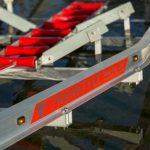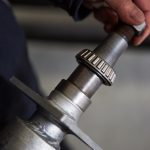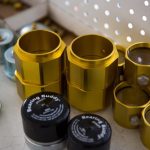The dreaded trailer failure can mess up your fishing trip and-much, much worse- your boat. Yet such a devastating towing trauma can be prevented with just a little forethought. Roll with me on this one…
ROLLIN’ BY THE RIVER
It’s a dark, moonless night and you’re cruising down the road en route to your secret fishing spot. The tunes are humming quietly while the wife and kids are in a deep slumber. Your belly is preoccupied with digesting a double quarter-pounder soaked in a chocolate shake. You imagine the perfect sunrise in the morning; visions of the perfect cast to your favourite tree stump…
Then your imagination is rudely interrupted as boat and trailer start snaking down the road behind you. You ease off the gas and clatter to a stop to review the carnage. Boat and trailer are leaning stubbornly to one side, springs collapsed under twisted metal. The tyres have been rubbing hard up against the steel, filling your nostrils with the acrid smell of mechanical failure. You’re 100km from nowhere and think it couldn’t get any worse. Then the missus wakes up, clears her eyes and gives you that “I’m deeply unimpressed with you right now” look. Seconds later, the damn kids wake up and start complaining about “why have we stopped?” and it finally occurs to you that maybe, just maybe, you should have bought a better trailer — or perhaps looked after this one. Here are some of the most common trailer problems and how to avoid them:
THE WHEEL DEAL
Overheating bearings are the most common trailer problem. A bearing is designed to hold grease or oil, lubricating small rollers within a housing. Over time, the grease will dissipate due to extreme heat and seepage. Without grease, water will enter the bearing and corrode the steel. Then, under load, the bearing will overheat and collapse and your wheel will either seize up or fall off. The two indicators for bad bearings are noise and heat. Keep an ear out when towing, and also put your hand around the hub after stopping to check for excessive heat (don’t worry, you’ll know!). This is more likely to occur when touring — when the boat is loaded with gear placing more pressure on the bearings.
Bearing buddies are a nifty product, enabling you to pump grease into the bearing. Pump in just enough so the front spring pops out — not too much or you’ll pop the seal on the inside of the hub. If you run oil-filled bearings, be sure to carry spare oil and top up regularly. Change your bearings once a year (whether you have buddies or not) and consider keeping a full replacement kit in your car for emergencies. Just make sure you have the right parts and tools to do the job. A practice run may save you a world of pain and lost time.
RUNAWAY TYRES
Have you ever been cruising down the highway, been overtaken by a bounding wheel and then realised it’s yours? Or perhaps you’ve had one come your way? Losing a wheel happens all too often. It’s usually just the wheel nuts and easy to prevent. Keep a wheel brace handy and tighten them up every couple of trips. Put a small amount of grease on the stud to make nut removal easier. Sadly, you can’t always trust your mechanic to look after your nuts. I took my trailer to a reputable tyre supplier only to watch my wheel bound down the road in excitement. The cause, as described by the fitter, was a faulty air compressor that didn’t generate enough pressure to drive his air gun. Bollocks!
PRESSURE TESTS & FRICTION FAILS
A patch of rubber no bigger than your hand separates your shiny new boat and trailer from the tarmac. If tyres run flat, there’s a good chance you’ll expose the weak sidewall to the road and damage them. Tyre walls can also be damaged when they rub against a curb. Over-inflating tyres can be just as wicked. We inadvertently ran truck tyres at the maximum load and they lasted about 50km before blowing to Kingdom Dumb.
Keep tyre pressure around 30–40psi (up to 50psi for 4WD tyres) and run 8-ply tyres rated for towing if you can. And avoid low-profile tyres, which may give you that Snoop Dog look, but won’t offer the same cushioning effect of a taller tyre. Tread is a critical component of tyres. Well, “der”, I hear you say, but it still surprises me how many people cruise down the highway in their 200 Series LandCruiser worth more than a small island, towing a trailer with tyres that ran bald some time before the Vietnam War.
The thing with tread is that it creates static friction and the more static friction at the contact point, the better the traction. Good tread assists this process. Jackknifing is not caused by heavy winds or unbalanced trailers, although they don’t help. It’s caused when tyres lose their grip (or friction) on the road and slide sideways.
IS IT WORTH THE WEIGHT?
Weight is the serial killer of trailers. It creates excessive stress on frames, springs and bearings. Many trailer-boat owners work the margins, staying just within legal limits for braked trailers. However, it all gets thrown out the door for the Christmas holidays when half a tonne of BCF product is loaded into the boat. Compounding the weight problem is that the load sits up above the axle, creating a higher centre of gravity and reducing stability. Another problem is sending weight too far forward in the boat (and onto the trailer hitch), which compromises the ride. Your suspension is supposed to absorb impact through the wheels — but not the weight of five Malvern Star bikes and a Swedish steel cross-country pram. Australian trailer manufacturers have compensated for our sins, building better-quality trailers with a lower centre of gravity. Ride quality has also improved with independent suspension.














































Recent Comments